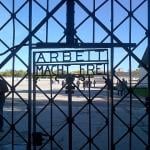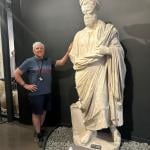 I continue to read Brant Pitre’s little book Jesus and the Jewish Roots of the Eucharist: Unlocking the Secrets of the Last Supper
I continue to read Brant Pitre’s little book Jesus and the Jewish Roots of the Eucharist: Unlocking the Secrets of the Last Supper. It is really good. What I love about Brant is that he knows his Old Testament and understands the importance of it for interpreting the New Testament. Every chapter of this little book unpacks an OT concept that sheds light on the NT. While we may disagree over readings of NT texts (e.g. John 6), there’s just no doubt that he’s doing a great service to the church by exposing the theological rich OT background of the NT. This book is so fun to read!
In chapter 5, Brant discusses the OT’s “Bread of Presence” (he calls it the “Bread of the Face” as the Hebrew word can mean either) as background for the Eucharist. The topic is found in Exodus 25:23-24, 29-30 and Leviticus 24:5-7. This little known item, the Bread of Presence, was one of the three objects kept in the Tabernacle along with the Ark of the Covenant and the golden Lampstand. As Bryant surmises:
The Bread of the Presence stood at the very center of Israelite worship . . . it was one of the three most sacred objects in the Holy Place . . . the Bread of the Presence was the Sabbath sacrifice, the “most holy” offering . . . it was both the sign of the “everlasting covenant” with Israel and the Bread of the Lord’s perpetual presence in the Tabernacle . . . Clearly, according to the Jewish Scripture, the mysterious Bread of the Presence was no ordinary bread (125).
Brant uncovers several traditions about the Bread of the Presence that were circulating at the time of Jesus. These traditions connected Melchizedek to the Bread of Presence linking the bread to an earlier time than the Sinai Covenant. Another tells of how the loaves of bread were shaped with “horns” resembling the bronze altar of sacrifice. In addition, there seems to be traditions attributing supernatural properties to the bread. One last tradition Brant mentions involves the removing of the Golden Table on which the bread sat in the Temple during the major pilgrimage feasts. When the bread was lifted the priests are attributed to have said “Behold, God’s love for you!” Bryant concludes this must mean that “the Bread of the Presence was a sign of God’s love because it was a sign of his covenant” (131). Bryant thinks that the reason the priests did this quite unprecedented action was to show the pilgrims the “face” of God which would have fulfilled the Law’s requirement that the pilgrims “see the Face” of the Lord (Exod. 34:23; 23:17)—the word “presence” is also the same Hebrew word for “face”.
What’s all this have to do with Jesus? First, it makes more sense of the story in Matthew 12:1-6 about the Sabbath controversy where Jesus appeals to David taking the Bread from the Tabernacle to feed his troops. The impact of the story when the background is considered is a claim that Jesus makes about his identity. In effect Jesus is saying, “I am like King David, and my disciples are like his followers, and we can act like priests, because David was a priest, according to the order of Melchizedek” (138).
Yet the primary pay dirt for Brant is the Lord’s Supper. First, Jews would have considered the bread and the wine a sign of divine presence—a point not obvious to modern readers. Second, Jesus was instituting the new Bread and wine of Presence, the bread of Jesus’ own presence. This perhaps explains why Jesus connected the bread and the wine so closely to himself.
Brant concludes:
If Jesus and the early Jewish Christians saw the Last Supper as the institution of the new Bread of the Presence, then it follows that they did not see it as ordinary bread and wine. It was, rather, the sign and instrument of Jesus’ real presence (146)











